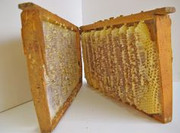...I had a slight panic attack after seeing this, but after I cut it out I see it was only a cluster of drone cells...
Jeff, are you referring to the small pieces of comb hanging down from the bottom of the frames? If yes, that is called 'burr comb' or 'ladder comb'. Bees commonly build it, and queens use it to lay drone eggs.
When you leave frames foundationless, the proportion of worker to drone comb is variable, but about 20-30% drone size (wild brood nests have a lot of brood comb too). When you use foundation, that percentage of drone comb goes down closer to 10%. Bees supplement their drone population by raising drone brood in the burr comb. This is normal. The only reason I remove it, (and I do), is to prevent squashing bees when reassembling the hive. When the drone brood hatches, bees often fill those cells with honey. HTH

Now, burr comb can take many other forms that give bees, (and pests & potential brood disease), a place to hide during inspections. If you look at the first picture below, the comb on the frame to the right was built entirely on the
side of the foundation, (caused by the beekeeper's violation of 'bee space'). Bees have made an entire honeycomb on the side of the foundation. You can't find the queen if she is back there, you can easily squash bees with pressure on the outside of the comb, and if there was a brood disease hiding back there you couldn't see it to know there was a problem that needed action.


Burr comb like this is caused by too much space between the frames. You can read about bee space
here, or you can do a search, it's an important concept in modern beekeeping.
